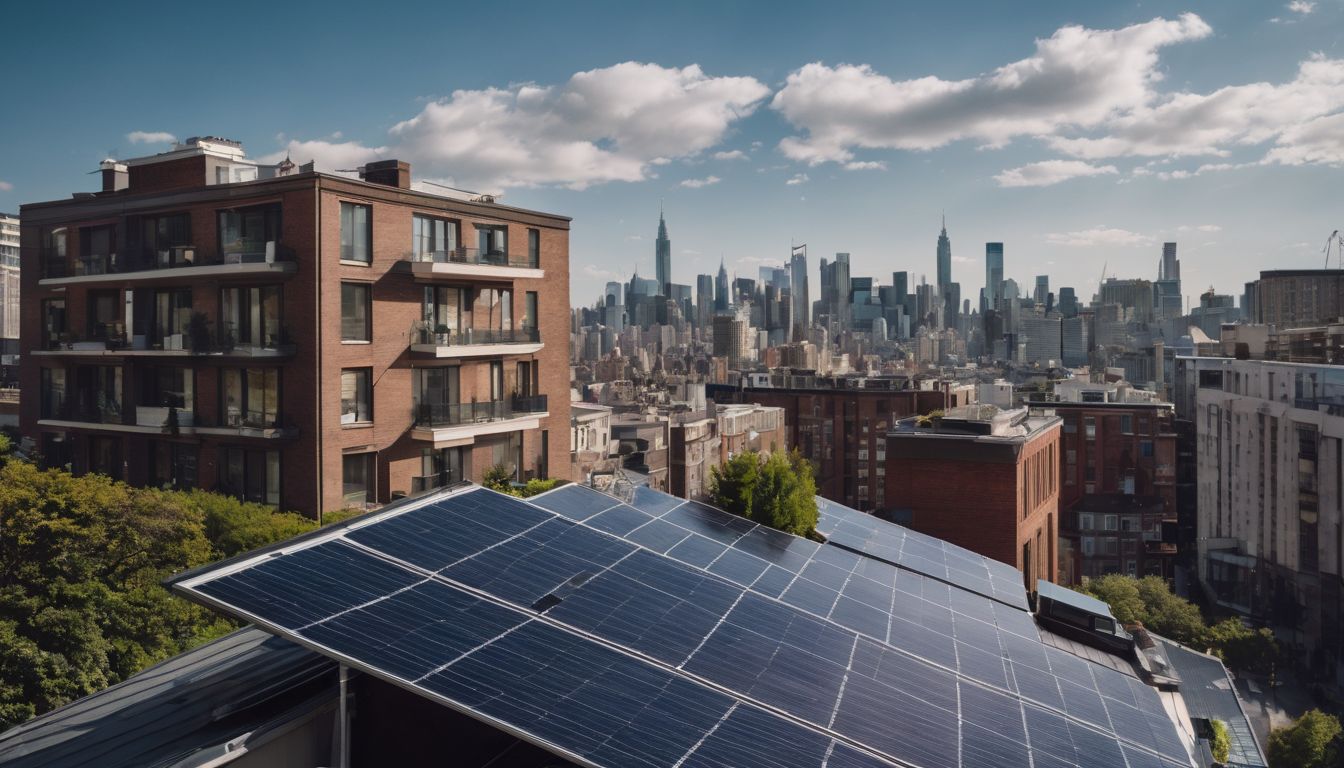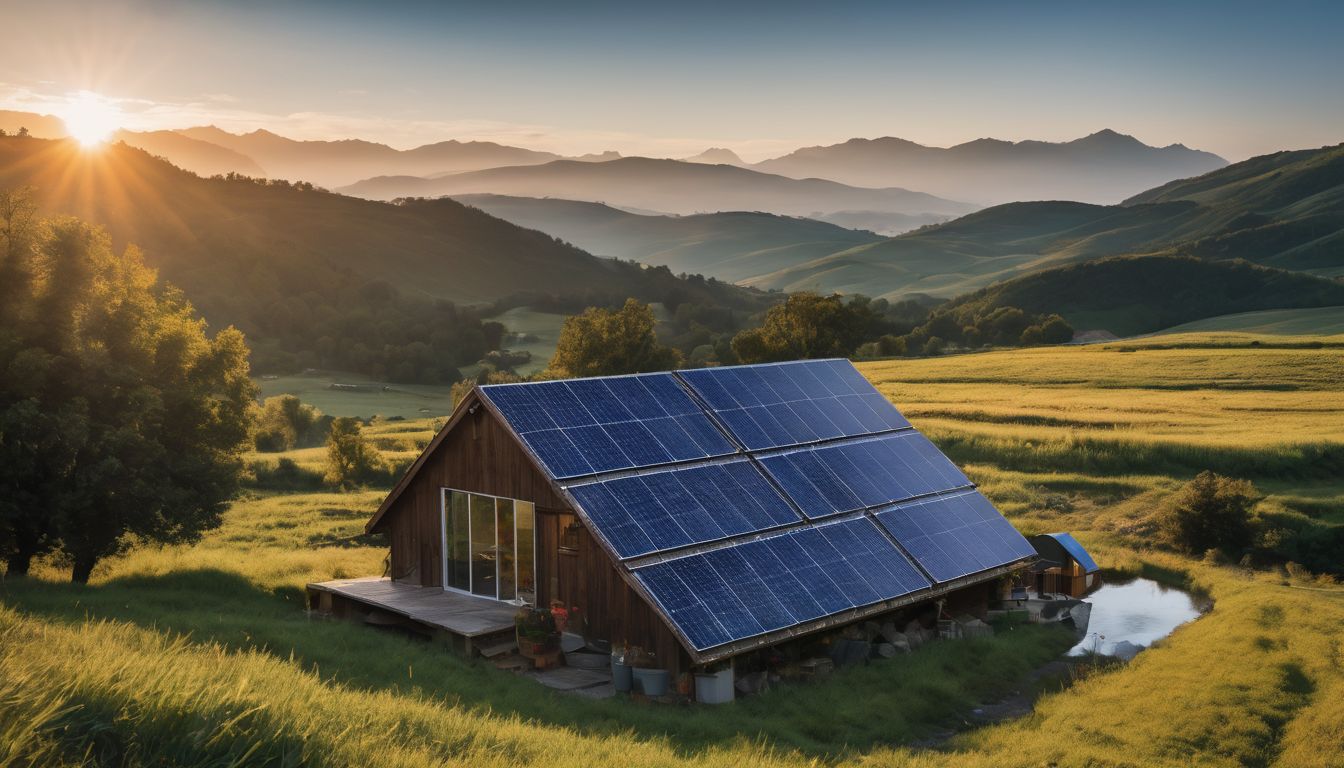When blackouts hit, we all feel vulnerable. Solar power is increasingly seen as a reliable ally during such crises, offering lights and energy when traditional systems fail. This article will explore the crucial role solar energy plays in preparing for and reacting to emergencies, ensuring you’re never left in the dark.
Keep reading; it’s enlightening!
Key Takeaways
- Solar power provides vital, independent energy during emergencies, reducing reliance on traditional grids and fossil fuels.
- Portable solar batteries enhance disaster resilience by offering flexible and immediate power sources for essential services like lighting and communication.
- Investing in solar panels is cost-effective over time, offering sustainable off-grid living options while supporting conservation efforts.
- Scalable and portable solar solutions offer swift deployment to disaster-stricken areas, aiding faster recovery and long-term stability.
- Future policies should focus on increasing the adoption of renewable energy to ensure ongoing emergency power access and support climate mitigation goals.
Solar Power in Emergency Situations
Solar power plays a crucial role in providing reliable and independent energy during emergency situations. It offers cost-effective solutions and can significantly contribute to disaster relief efforts.
Advantages in Disaster Relief
In the midst of natural disasters, solar energy becomes a critical lifeline. As traditional power grids fail, solar panels provide an immediate source of electricity to affected areas.
People can charge mobile phones, operate medical equipment and light up emergency shelters with the sun’s power. This swift response enhances disaster preparedness and ensures that vital services remain uninterrupted.
Portable solar batteries also offer flexibility during crisis situations. Instead of relying on scarce fuel supplies for generators, emergency management teams harness sunlight to create clean energy on-site.
These off-grid solutions greatly improve disaster resilience, giving survivors and rescue teams a reliable power supply without further straining local resources or causing additional environmental harm.
Reliability and Independence
Solar power provides reliable and independent energy during emergencies, ensuring a dependable source of electricity when traditional power grids fail. This independence eliminates the reliance on external resources, allowing for self-sufficiency in providing essential energy needs.
Sustainable energy sources like solar panels offer a reliable solution for off-grid living, giving individuals the freedom to generate their own power independently from centralised utility companies.
Utilising renewable energy ensures resilience against power outages and reduces dependency on fossil fuels, contributing to long-term energy sustainability.
The cost-effectiveness and practicality of solar solutions make them an attractive option for environmentally conscious individuals seeking sustainable emergency power solutions. Additionally, embracing solar technology promotes grid independence at both individual and community levels, fostering greater resilience in facing unexpected challenges such as natural disasters or crises.
Cost-Effectiveness
Solar power offers a cost-effective solution for emergency preparedness. By harnessing the sun’s energy, individuals can reduce their reliance on expensive fossil fuels and mitigate the impact of power outages during crises.
This approach provides a sustainable and economical way to ensure energy resilience in off-grid living situations, disaster response efforts, and ongoing emergency power access.
Furthermore solar solutions offer an opportunity to support conservation efforts while also promoting environmentally conscious choices. By investing in solar panels for preparedness, individuals can contribute to social development impacts by reducing carbon emissions and supporting relief efforts in a cost-effective manner.
Solar Panels for Preparedness
Solar panels are a scalable and portable solution for emergency preparedness, providing independence from traditional power sources. By reducing fossil fuel dependency, solar panels offer a sustainable offgrid living option for crisis response.
Scalability and Portability
Solar panels are scalable and portable, making them suitable for various emergency situations. The ability to easily expand the solar power system means it can meet changing energy needs during a crisis.
In addition, the portability of solar panels allows for quick deployment to different locations, providing sustainable power sources where they are most needed. Offgrid living and emergency response benefit greatly from these adaptable and mobile solar solutions.
Furthermore, scalability and portability improve crisis response capabilities by reducing dependence on traditional fuel sources. This not only lessens environmental impact but also ensures continuous access to electricity independent of fossil fuels.
Reducing Fossil Fuel Dependency
To reduce fossil fuel dependency, embracing solar power is crucial. It offers a sustainable alternative to traditional energy sources, decreasing our reliance on non-renewable fuels.
By harnessing the sun’s energy, we can mitigate environmental impact and contribute to conservation efforts. Embracing off-grid solutions like solar power is an effective way for environmentally conscious individuals to support conservation and environmental sustainability.
Transitioning to solar energy reduces our carbon footprint and lessens the strain on non-renewable resources, leading us towards a more sustainable future. This shift aligns with the values of those who prioritise environmental responsibility and seek practical ways to reduce their ecological impact.
Impact of Solar Power on Disaster Response and Recovery
Solar power plays a crucial role in disaster response and recovery by providing sustainable energy solutions for affected areas. It not only facilitates post-disaster recovery but also has positive impacts on social development.
Post-Disaster Recovery
In post-disaster recovery, solar power plays a crucial role in providing sustainable energy solutions. Communities can leverage offgrid solar solutions to quickly restore power and essential services, reducing their reliance on traditional energy sources.
Solar panels facilitate a speedier recovery process while also supporting social development initiatives. Moreover, the use of solar power in disaster recovery efforts contributes to overall environmental conservation and resilience building within affected areas.
Solar technology enables communities to rebuild faster by providing immediate access to clean and reliable energy resources. This has an enduring impact on the long-term sustainability and stability of regions recovering from disasters, creating opportunities for economic growth and sustainable infrastructure development.
Social Development Impacts
In post-disaster recovery, the social development impacts of integrating solar power are significant. Access to renewable energy sources enhances community resilience and reduces vulnerability to future disasters.
Solar solutions provide reliable electricity, powering essential services such as healthcare facilities, schools, and communication networks in affected areas. This fosters a sense of stability and continuity within communities, enabling quicker recovery and reducing long-term disruption to social structures.
Furthermore, embracing solar technology encourages economic empowerment by creating opportunities for local employment and skill development in installing and maintaining solar infrastructure.
Challenges and Opportunities
Challenges in implementing solar power for emergency preparedness include initial costs and technical expertise. However, opportunities arise in integrating solar energy into relief efforts, providing sustainable solutions for power access during disasters.
Implementation Challenges
- Initial set – up costs can be expensive, requiring significant investment.
- Storage solutions for solar energy may be limited, affecting power availability during periods of low sunlight.
- Maintenance and repair of solar panels and equipment require specialised skills and resources.
- Availability of suitable space for solar panel installation may be restricted, especially in urban areas.
Opportunities in Relief Efforts
Solar power presents various opportunities in relief efforts during emergencies and disasters:
- Providing immediate access to electricity for charging communication devices and medical equipment, aiding communication and emergency response.
- Offering sustainable power sources for temporary shelters and field hospitals, reducing reliance on limited fossil fuel supplies.
- Facilitating water purification through solar – powered systems, ensuring access to clean drinking water in affected areas.
- Supporting the operation of refrigeration units for preserving food and medication, minimising spoilage and health risks.
- Enabling the use of solar cookers for preparing meals in disaster-stricken regions, ensuring food security without depleting traditional fuel resources.
Future Outlook and Policy Directions
The future of emergency preparedness involves a shift towards sustainable policies and a focus on climate mitigation. Solar power is expected to play a crucial role in ongoing emergency power access, providing reliable and independent energy sources for disaster relief efforts.
Climate Mitigation Motivation
Climate mitigation is a pressing motivator that drives the adoption of solar power in emergency preparedness. By harnessing solar energy, individuals and communities contribute to reducing greenhouse gas emissions, thereby helping to mitigate the impact of climate change.
The transition towards sustainable energy sources like solar power supports conservation efforts and promotes environmental resilience. This motivation aligns with the values of environmentally conscious individuals who seek practical solutions to address climate challenges.
Furthermore, embracing solar energy for emergency preparedness not only enhances environmental sustainability but also contributes to ongoing emergency power access. This dual benefit underscores the importance of pursuing sustainable policies that prioritise renewable energy sources such as solar power.
Ongoing Emergency Power Access
Ensuring ongoing emergency power access is crucial for disaster-prone areas. Solar power offers a reliable solution, providing continuous energy supply during and after disasters, helping to maintain essential services such as hospitals, shelters, and communication networks.
By incorporating solar panels into emergency response plans, communities can reduce their dependence on traditional electricity sources and improve their resilience in the face of future crises.
Solar power not only provides immediate relief but also contributes to long-term sustainable development. As governments and organisations promote the integration of solar energy into emergency preparedness strategies, they pave the way for more environmentally friendly and cost-effective solutions that benefit both people and the planet.
Toward Sustainable Policies
Policymakers must prioritise sustainable energy policies to ensure resilience during disasters. Encouraging investment in solar technology and integrating it into emergency response plans is crucial for long-term environmental conservation and disaster preparedness.
By promoting sustainable policies, communities can reduce their reliance on non-renewable resources, contributing to a more eco-friendly and resilient future.
Moving towards sustainable policies requires proactive steps such as incentivising renewable energy adoption, creating regulatory frameworks that support clean energy integration, and fostering public-private partnerships to drive innovation in the renewable sector.
Conclusion
In conclusion, solar power plays a crucial role in emergency preparedness by providing reliable and independent energy during disasters. Its scalability and portability make it an essential resource for relief efforts.
The future outlook emphasises the need for sustainable policies to continue promoting solar energy’s vital role in ensuring ongoing emergency power access. In supporting conservation and environmental initiatives, individuals and communities can actively contribute to the effective use of solar power in disaster response and recovery.
FAQs
1. Why is solar power important for emergency preparedness?
Solar power provides a reliable source of energy during emergencies, ensuring that essential equipment and lights stay on even if the main grid fails.
2. Can solar panels charge emergency gadgets?
Yes, solar panels can efficiently charge emergency gadgets such as radios, flashlights, and mobile phones when there’s a power outage.
3. How does solar energy help in disaster situations?
In disaster situations, having access to solar energy means you can generate your own electricity to run vital appliances without relying on traditional power sources.
4. Should I consider installing a solar generator for emergencies?
Certainly! A portable or installed solar generator acts as an excellent backup, providing clean and renewable power during critical times of need.





